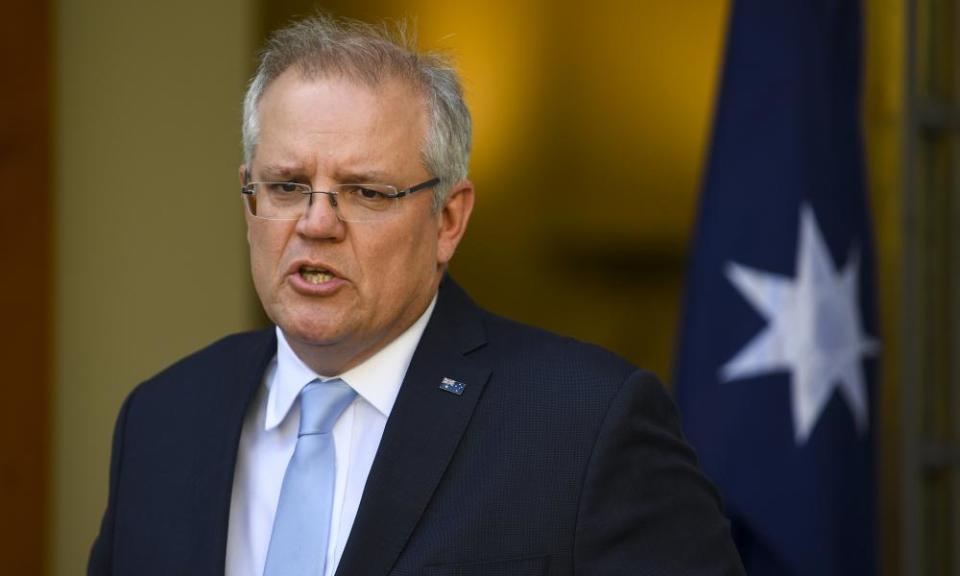Employers warn $1.5bn apprentice wage boost may not be enough to create new jobs

Employers have welcomed the government’s $1.5bn expansion of wage subsidies to arrest the decline in apprenticeships, but have already warned more incentives may be required to encourage school leavers to take up new apprenticeships.
The Western Australian government has also warned the federal jobtrainer package “would take crucial local decision-making ability” from the state, in the first sign of resistance to the federal government’s intervention to overhaul vocational education.
On Thursday Scott Morrison and the skills minister, Michaelia Cash, announced the extension of wage subsidies to medium-sized businesses in a bid to support 180,000 apprentices to keep employment and reconnect up to 16,000 people who have had their apprenticeships suspended or cancelled.
Under the expanded policy, apprentices employed by small businesses on 1 March or 1 July and apprentices in medium businesses of up to 199 employees on 1 July are eligible for a 50% wage subsidy, up to a limit of $7,000 per quarter.
Related: Scott Morrison says economy 'fighting back' despite almost a million unemployed
The policy applies only to existing apprentices. But the subsidies are available to any employer that engages an eligible apprentice, meaning that big business could also benefit by taking on apprentices laid off by a different company.
The jobtrainer plan also includes $500m for 340,700 training places, available from September, to be delivered by Tafe or private training providers.
The Australian Industry Group chief executive, Innes Willox, said the wage subsidy program “is a support rather than an incentive and hopefully it will put a floor under our declining apprentice numbers as the economy stabilises”.
“If the economy continues to decline obviously new measures will be required to encourage employers to take on school leavers as new apprentices,” he said.
Willox said the 7.4% unemployment rate announced on Thursday was “a salient reminder of the pressures this year’s school leavers will be facing” and said AiGroup would continue to “work with the government to identify meaningful ways to support youth”.
The chief executive of the Australian Chamber of Commerce and Industry, James Pearson, said it would also work with the government on “appropriate incentives to encourage new apprentices and trainees as the economy recovers and there are more job opportunities available”.
The Australian Council of Trade Unions president, Michele O’Neil, said the policy “restores some of the money in the training sector but it needs to be targeted to Tafe, which we know works, not handed over to the privatised sector, which we know is full of dodgy providers.
“Not only does this wage subsidy only reach existing apprentices, it expires in March 2021,” she said.
O’Neil called on the government to create a “real pathway” from skills development to work by mandating a minimum number of apprentices on government projects.
Related: Joining the job queue: 'I never wanted to rely on Centrelink. It beats people down'
At a press conference in Canberra, Morrison and Cash defended the fact wage subsidies were limited to existing apprentices.
“It’s important for people – if they want to take on new apprentices – that they are able to hold their current apprentices, and that is the most urgent need as we speak right now,” Morrison said.
Cash said 6% of apprentices – or some 16,000 – had “either been suspended or cancelled” during the Covid-19 recession.
Since the government first offered increased wage subsidies to apprentices in small businesses in March, the program had supported 80,000 apprentices’ jobs, set to rise to up to 180,000 under the expanded policy, she said.
Willox said as many as 25,000 apprentices had been stood down, suspended or cancelled since March with “predictions there could be 78,000 fewer apprentices and trainees in training by December out of an in-training stock of only 196,930”.
Earlier, on 2GB Radio, Cash spruiked the benefits of the policy by claiming “if someone picks you [the apprentice] up, that’s the good news, they will qualify for the wage incentive”.
However, it is unclear how many of the 16,000 apprentices out of work are eligible for increased subsidies, with fears that those employed by larger businesses or who were formerly employed by medium businesses but not on the critical 1 July eligibility date are set to miss out.
Asked why the 1 July date was set, a spokesman for Cash said the subsidy was “designed to target the retention of existing apprentices, in recognition of the significant investment already made into their training”.
So far New South Wales, Tasmania, South Australia, Queensland, the Northern Territory and the ACT have signed up to the jobtrainer plan, which requires them to match $500m in skills funding and to sign up to a new heads of agreement that will specify reforms to the vocational education system.
But a spokesman for the WA government told Guardian Australia that while it welcomed the apprenticeship subsidies “with respect to jobtrainer, the proposal in its current form would take crucial local decision-making ability from WA”.
“We look forward to working with the federal government to resolve these issues before a decision is made.”
Labor’s education spokeswoman, Tanya Plibersek, said the opposition would support the apprenticeship subsidy if the plan “will better support apprentices and keep people in jobs”, but it “doesn’t do enough to get more Australians to take up a trade apprenticeship”.
“It’s very disappointing the Liberals didn’t do more sooner,” she said. “It has cost many people their livelihoods.”
Plibersek also noted the federal and state funding only amounted to $300 per course and questioned how the government would guarantee quality, arguing the effect of the policy could be “to artificially suppress Australia’s unemployment numbers by funnelling young people into cheap, dodgy short courses”.

 Yahoo News
Yahoo News 